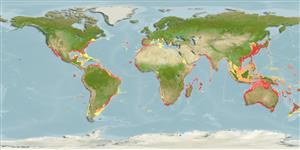Common names from other countries
分類 / Names
俗名 | 同種異名 | Catalog of Fishes(屬, 種) | ITIS | CoL | WoRMS | Cloffa
Elasmobranchii
板鰓亞綱 (鯊魚與魟魚) (sharks and rays) >
Carcharhiniformes (Ground sharks)
真鯊目 (Ground sharks) >
Carcharhinidae (Requiem sharks)
白眼鮫科 (Requiem sharks)
Etymology: Carcharhinus: karcharos (Gr.), sharp or jagged; rhinus, an ancient name for sharks, from rhine (Gr.), rasp, both words alluding to a shark's jagged, rasp-like skin. (See ETYFish); brachyurus: a- (Gr.), not; carenatus, alternate spelling of carinatus (L.), keeled or carinate, referring to absence of dermal fold (dorsal ridge) between the dorsal fins [treated as a junior synonym of C. brachyurus by some workers]. (See ETYFish).
More on author: Günther.
Issue
Carcharhinus acarenatus Moreno & Hoyos, 1983 may be a valid species. See ECoF.
Environment: milieu / climate zone / depth range / distribution range
生態學
海洋; 半鹹淡水 礁區魚類; 海洋洄游的 (Ref. 51243); 深度上下限 0 - 360 m (Ref. 58018). 亞熱帶的; 45°N - 52°S, 122°W - 180°E
Western Atlantic: Mexico, Gulf of Mexico, Brazil to Argentina. Eastern Atlantic: off France southward and around the coast of southern Africa to central Natal, South Africa (Ref. 5578), including the Mediterranean. Possibly two separate populations in southern Africa (Ref. 3209). Western Pacific: Japan to New Zealand. Eastern Pacific: southern California, USA to the Gulf of California in Mexico and Peru.
西大西洋: 墨西哥,墨西哥灣巴西到阿根廷。 東大西洋: 外海的法國南方與非洲南部到南非納塔爾中部 (參考文獻 5578) 的海岸的周圍, 包括地中海。 在非洲南部中的可能兩個分開的族群.(參考文獻 3209) 西太平洋: 日本到紐西蘭。 東太平洋: 美國的南加州到墨西哥與祕魯的加州灣。
Length at first maturity / 大小 / 重量 / 年齡
Maturity: Lm 230.0, range 245 - 240 cm
Max length : 325 cm TL 雄魚/尚未辨別雌雄; (Ref. 2334); 最大體重: 304.6 kg (Ref. 40637); 最大年齡: 30 年 (Ref. 3209)
背棘 (總數) : 0; 臀棘: 0. A large shark to with a bluntly pointed, broad snout, narrow, bent cusps on the upper teeth, and with no interdorsal ridge (Ref. 5578). Grey to bronzy in color, white below (Ref. 5578); fins mostly plain except for dusky tips on pelvic fins, as well as dusky to black tips and rear edges on pectoral fins (Ref. 9997).
一隻大的鯊魚具有一個頓尖的, 寬的吻﹐狹窄的﹐和彎曲的尖頭在上顎齒上, 而且沒有間背脊.(參考文獻 5578) 灰色的到青銅色顏色, 腹面白色的;(參考文獻 5578) 鰭大部份單色在腹鰭上除了暗色的尖端, 以及在胸鰭上的暗色到黑色的頂端與後緣.(參考文獻 9997)
A coastal and offshore shark (Ref. 9997) found along continental margins in most tropical and temperate seas. Occasionally enters large coastal bays and inshore areas (Ref. 6390). Occasionally found near the bottom (Ref. 6808). Migratory in the northern part of its range, moving northward in spring and summer and southward in autumn and winter (Ref. 244). Feeds on pelagic and bottom bony fishes, cephalopods, and small sharks and rays (Ref. 5578). Viviparous (Ref. 50449). Undoubtedly utilized for human consumption where it occurs (Ref. 244). Implicated in shark attacks on people (Ref. 9997).
一隻海岸與外海鯊魚 (參考文獻 9997) 在大多數的熱帶與溫帶的海洋中發現沿著大陸的邊緣了。 偶然地進入大的近岸海灣與近海區域。 (參考文獻 6390) 偶然地在底部的附近發現。 (參考文獻 6808) 迴游的在被春天與夏天向北遷移的它的分佈範圍的北部與往南秋天與冬天時.(參考文獻 244) 吃大洋性與底棲性的硬骨魚類,頭足類動物與小的鯊魚與魟。 (參考文獻 5578) 胎生的.(參考文獻 50449) 毫無疑問地供人類消費使用了在那裡它出現.(參考文獻 244) 關係到鯊魚對人的攻擊了。 (參考文獻 9997)
Viviparous, with a yolk-sac placenta. Litter contains 7 to 20 pups (Ref. 6871, 6390). Young born at 59 - 70 cm TL (Ref. 6390). Pupping may occur at any time of the year but there is a peak in births in summer (Ref. 6390). Distinct pairing with embrace (Ref. 205).西大西洋: 墨西哥,墨西哥灣巴西到阿根廷。 東大西洋: 外海的法國南方與非洲南部到南非納塔爾中部 (參考文獻 5578) 的海岸的周圍, 包括地中海。 在非洲南部中的可能兩個分開的族群.(參考文獻 3209) 西太平洋: 日本到紐西蘭。 東太平洋: 美國的南加州到墨西哥與祕魯的加州灣。
Compagno, L.J.V., 1984. FAO Species Catalogue. Vol. 4. Sharks of the world. An annotated and illustrated catalogue of shark species known to date. Part 2 - Carcharhiniformes. FAO Fish. Synop. 125(4/2):251-655. Rome: FAO. (Ref. 244)
人類使用
漁業: 低經濟; 游釣魚種: 是的
工具
特別的報告
下載 XML
網路資源
Estimates based on models
Preferred temperature (Ref.
115969): 11.6 - 23.8, mean 17.4 (based on 797 cells).
Phylogenetic diversity index (Ref.
82804): PD
50 = 0.5000 [Uniqueness, from 0.5 = low to 2.0 = high].
Bayesian length-weight: a=0.00468 (0.00230 - 0.00950), b=3.08 (2.91 - 3.25), in cm Total Length, based on LWR estimates for this species & Genus-body shape (Ref.
93245).
營養階層 (Ref.
69278): 4.5 ±0.0 se; based on diet studies.
回復力 (Ref.
120179): 非常低的, 最小族群倍增時間超過14 年 (K=0.04; tm=5-20; tmax=30; Fec=7).
Fishing Vulnerability (Ref.
59153): Very high vulnerability (87 of 100).
Climate Vulnerability (Ref.
125649): High vulnerability (57 of 100).
